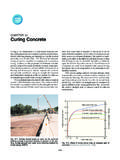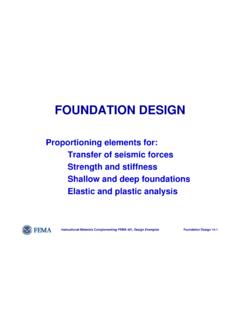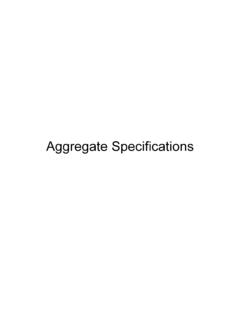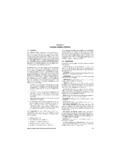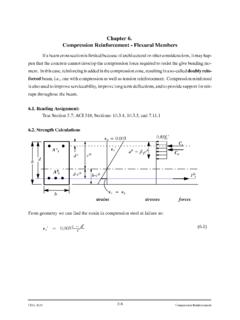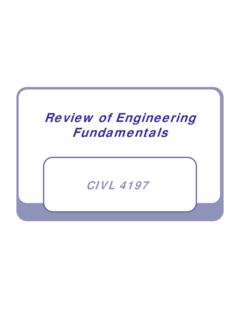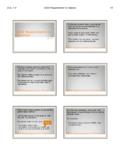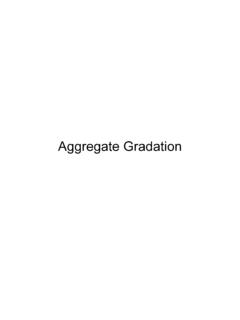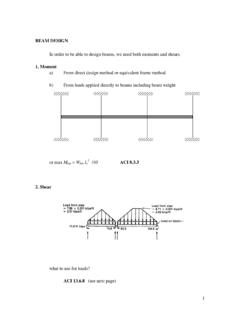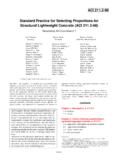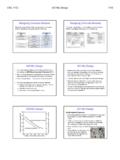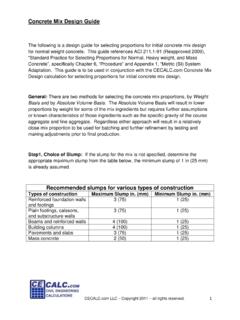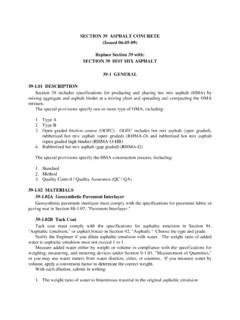Transcription of Aggregates for Concrete
1 The importance of using the right type and quality ofaggregates cannot be overemphasized. The fine andcoarse Aggregates generally occupy 60% to 75% of theconcrete volume (70% to 85% by mass) and strongly influ-ence the Concrete s freshly mixed and hardened proper-ties, mixture proportions , and economy. Fine Aggregates (Fig. 5-1) generally consist of natural sand or crushedstone with most particles smaller than 5 mm ( in.).Coarse Aggregates (Fig. 5-2) consist of one or a com-CHAPTER 5 Aggregates for Concretebination of gravels or crushed stone with particlespredominantly larger than 5 mm ( in.)
2 And generallybetween mm and mm (3 8in. and 11 2in.). Somenatural aggregate deposits, called pit-run gravel, consistof gravel and sand that can be readily used in concreteafter minimal processing. Natural gravel and sand areusually dug or dredged from a pit, river, lake, or stone is produced by crushing quarry rock, boul-ders, cobbles, or large-size gravel. Crushed air-cooledblast-furnace slag is also used as fine or coarse Aggregates are usually washed and graded at thepit or plant. Some variation in the type, quality, cleanli-ness, grading, moisture content, and other properties isexpected.
3 Close to half of the coarse Aggregates used inportland cement Concrete in North America are gravels;most of the remainder are crushed occurring Concrete Aggregates are a mixtureof rocks and minerals (see Table 5-1). A mineral is a natu-rally occurring solid substance with an orderly internalstructure and a chemical composition that ranges withinnarrow limits. Rocks, which are classified as igneous, sedi-mentary, or metamorphic, depending on origin, are gener-ally composed of several minerals. For example, granitecontains quartz, feldspar, mica, and a few other minerals;most limestones consist of calcite, dolomite, and minoramounts of quartz, feldspar, and clay.
4 Weathering anderosion of rocks produce particles of stone, gravel, sand,silt, and Concrete , or crushed waste Concrete , is afeasible source of Aggregates and an economic reality,especially where good Aggregates are scarce. Conven-tional stone crushing equipment can be used, and newequipment has been developed to reduce noise and must conform to certain standards foroptimum engineering use: they must be clean, hard,strong, durable particles free of absorbed chemicals, coat-ings of clay, and other fine materials in amounts that couldaffect hydration and bond of the cement paste.
5 Aggregateparticles that are friable or capable of being split are unde-sirable. Aggregates containing any appreciable amountsof shale or other shaly rocks, soft and porous materials,Fig. 5-1. Closeup of fine aggregate (sand). (69792)Fig. 5-2. Coarse aggregate . Rounded gravel (left) andcrushed stone (right). (69791)79 HOMEPAGE should be avoided; certain types of chert should be espe-cially avoided since they have low resistance to weather-ing and can cause surface defects such as of the constituents of an aggregatecannot alone provide a basis for predicting the behavior ofaggregates in service.
6 Visual inspection will often discloseweaknesses in coarse Aggregates . Service records areinvaluable in evaluating Aggregates . In the absence of aperformance record, the Aggregates should be testedbefore they are used in Concrete . The most commonly usedaggregates sand, gravel, crushed stone, and air-cooledblast-furnace slag produce freshly mixed normal-weightconcrete with a density (unit weight) of 2200 to 2400kg/m3(140 to 150 lb/ft3). Aggregates of expanded shale,clay, slate, and slag (Fig. 5-3) are used to produce struc-tural lightweight Concrete with a freshly mixed densityranging from about 1350 to 1850 kg/m3(90 to 120 lb/ft3).
7 Other lightweight materials such as pumice, scoria,perlite, vermiculite, and diatomite are used to produceinsulating lightweight concretes ranging in density fromabout 250 to 1450 kg/m3(15 to 90 lb/ft3). Heavyweightmaterials such as barite, limonite, magnetite, ilmenite,hematite, iron, and steel punchings or shot are used toproduce heavyweight Concrete and radiation-shieldingconcrete (ASTM C 637 and C 638). Only normal-weightaggregates are discussed in this chapter. See Chapter 18for special types of Aggregates and Aggregates should meet the require-ments of ASTM C 33 or AASHTO M 6/M 80.
8 These speci-fications limit the permissible amounts of deleterioussubstances and provide requirements for aggregate char-acteristics. Compliance is determined by using one ormore of the several standard tests cited in the followingsections and tables. However, the fact that aggregatessatisfy ASTM C 33 or AASHTO M 6/M 80 requirementsdoes not necessarily assure defect-free adequate consolidation of Concrete , the desirableamount of air, water, cement, and fine aggregate (that is,the mortar fraction) should be about 50% to 65% byabsolute volume (45% to 60% by mass).
9 Rounded aggre-gate, such as gravel, requires slightly lower values, whilecrushed aggregate requires slightly higher values. Fineaggregate content is usually 35% to 45% by mass orvolume of the total aggregate OF AGGREGATESThe important characteristics of Aggregates for Concrete arelisted in Table 5-2 and most are discussed in the followingsection:GradingGrading is the particle-size distribution of an aggregate asdetermined by a sieve analysis (ASTM C 136 or AASHTO80 Design and Control of Concrete Mixtures EB001 Table 5-1. Rock and Mineral Constituents inAggregatesMineralsIgneous rocksMetamorphic rocksSilicaGraniteMarbleQuartzSyeniteMet aquartziteOpalDioriteSlate ChalcedonyGabbroPhyllite TridymitePeridotiteSchist CristobalitePegmatiteAmphibolite SilicatesVolcanic glassHornfels FeldsparsObsidianGneiss Ferromagnesian PumiceSerpentiniteHornblendeTuffAugite ScoriaClayPerliteIllitesPitchstoneKaolin sFelsiteChloritesBasaltMontmorillonitesM icaSedimentary rocksZeoliteConglomerateCarbonateSandsto neCalciteQuartziteDolomiteGraywackeSulfa teSubgraywackeGypsumArkoseAnhydriteClays tone.)
10 Siltstone,Iron sulfideargillite, and shalePyriteCarbonatesMarcasiteLimestoneP yrrhotiteDolomiteIron oxideMarlMagnetiteChalkHematiteChertGoet hitelmeniteLimoniteFor brief descriptions, see Standard Descriptive Nomenclature ofConstituents of Natural Mineral Aggregates (ASTM C 294).Fig. 5-3. Lightweight aggregate . Expanded clay (left) andexpanded shale (right). (69793)T 27). The range of particle sizes in aggregate is illustratedin Fig. 5-4. The aggregate particle size is determined byusing wire-mesh sieves with square openings. The sevenstandard ASTM C 33 (AASHTO M 6/M 80) sieves for fineaggregate have openings ranging from 150 m to mm(No.
